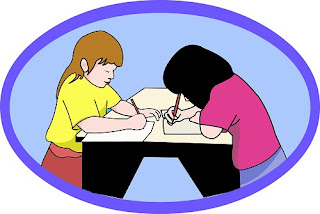 From three different sources, there is basically one underlying definition for peer editing. According to the first two sources, the definition for peer editing is: working with someone your own age to help improve his or her writing. In the video presentation, What is Peer Editing, and also the powerpoint presentation, Peer Edit with Perfection Tutorial, there are three steps in peer editing. The first step is to give compliments. The video and the power point mention to always stay positive and to always start with compliments. Thinking about your own blog, you wouldn't want someone to be harsh when editing your own blog, so put yourself in the other person's shoes and be positive. The second step is give suggestions. Suggestions can be defined as specific ideas on how to make writing better. As an editor, you must keep in mind the word choice, organization, the use of detail, sentences, and topic. Lastly, you make corrections. Again, you must approach in a formal and positive fashion. As the editor, look out specifically for punctuation, grammar, sentences, and spelling.
From three different sources, there is basically one underlying definition for peer editing. According to the first two sources, the definition for peer editing is: working with someone your own age to help improve his or her writing. In the video presentation, What is Peer Editing, and also the powerpoint presentation, Peer Edit with Perfection Tutorial, there are three steps in peer editing. The first step is to give compliments. The video and the power point mention to always stay positive and to always start with compliments. Thinking about your own blog, you wouldn't want someone to be harsh when editing your own blog, so put yourself in the other person's shoes and be positive. The second step is give suggestions. Suggestions can be defined as specific ideas on how to make writing better. As an editor, you must keep in mind the word choice, organization, the use of detail, sentences, and topic. Lastly, you make corrections. Again, you must approach in a formal and positive fashion. As the editor, look out specifically for punctuation, grammar, sentences, and spelling.
In the third and final resource, Writing Peer Review Top 10 Mistakes, students reenact how to not act when peer editing. The students share many examples, such as Picky Patty, Whatever William, Social Sammy, Jean the Generalizer, etc. All in all, the students are showing how not to be when you're editing someone else's paper, but in a funnier version than the first two sources. Overall, the steps to peer editing effectively, is to: compliment, suggest, and correct. Always stay positive; there has to be at least one good thing the blogger noted, so take note and show that you, as the editor, saw that. As peer editors, we are trying to improve, not tear down.
I love how you made a separate paragraph for the third article since it was not just like the other two articles. I believe the stay positive rule is the most important. The only suggestion I have is that in the first paragraph you go into detail on the compliment and suggestion section. You did not go into that much detail on the third step. Other than that, great passage and writing.
ReplyDeleteI believe you summarized the videos and powerpoint quite well. You hit all of the main points that I touched on in my blog as well. It is very important to put yourself in the other person's shoes when peer editing. The children in the video were using a rubric similar to the ones we were making in class 6/4/15. That was a great way to adapt the in class lesson to the out of class work. I like your use of pictures. It makes your post more colorful and interesting.
ReplyDeleteThorough, thoughtful, well written.
ReplyDeleteExcellent! Well Written.
ReplyDelete